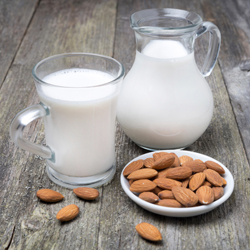Almond Milk
 For those of you who have never heard of almond milk, you may be wondering how milk is made from something other than a cow. Almond milk is made by blending pre-soaked almonds with water. This mixture is put into a mesh bag to filter the “milk” while leaving behind all of the almond chunks. This simple process produces the creamy and nutty tasting beverage we call almond milk.
For those of you who have never heard of almond milk, you may be wondering how milk is made from something other than a cow. Almond milk is made by blending pre-soaked almonds with water. This mixture is put into a mesh bag to filter the “milk” while leaving behind all of the almond chunks. This simple process produces the creamy and nutty tasting beverage we call almond milk.
With all of the other milk substitutes out there (such as soy, rice, and coconut milk) it can be hard to figure out which kind to drink. Almond milk can be a healthy alternative to cow’s milk if you follow a vegan diet, or if you have milk allergy or you’re lactose intolerant. Almond milk has no saturated fat or cholesterol and is lactose and soy free – perfect for someone who is lactose intolerant or allergic to soy or dairy. Most brands of almond milk are fortified with calcium and vitamin D (which your body needs to absorb calcium) and may have even more calcium and vitamin D than cow’s milk. Almond milk is naturally low in protein; it has 1 gram of protein compared to the 8 grams of protein found in cow’s milk. If you’re looking for a lactose-free beverage that is a good source of protein, soymilk is a good choice. Similar to cow’s milk, soymilk contains 8 grams of protein. You can also look for almond milk that has extra protein added to it or drink lactose-free cow’s milk.
It’s always smart to check the ingredients when looking at new products. The more ingredients you can recognize and understand the better. The ingredients for cow’s milk are milk and vitamin D3, very straightforward and easy to understand. However, the ingredients for almond milk are almond milk (water and almonds) and it continues on to list eight more ingredients. These ingredients are mainly additives such as vitamins and other elements to help delay its expiration. This comparison shows you that almond milk needs a lot more additives to help meet a person’s nutrient guidelines. Although many of the nutrients in almond milk aren’t naturally found in almonds, your body is still able to process the added nutrients and use them.
If you’re interested in giving almond milk a go, try putting it in your smoothie, coffee, or even in your breakfast cereal to get a feel for the taste. You can find it at most grocery stores. It comes in many flavors such as vanilla, chocolate, plain sweetened, or plain unsweetened making it easy to satisfy everyone’s taste buds!
-Shelby

